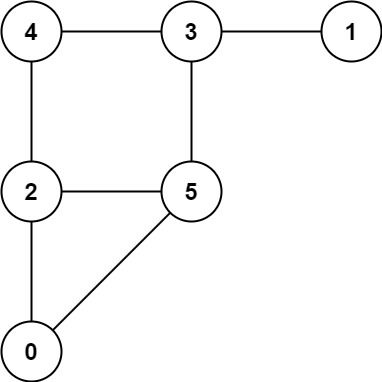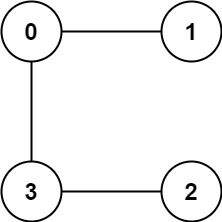| comments | difficulty | edit_url | tags | ||||||
|---|---|---|---|---|---|---|---|---|---|
true |
Hard |
|
A game on an undirected graph is played by two players, Mouse and Cat, who alternate turns.
The graph is given as follows: graph[a] is a list of all nodes b such that ab is an edge of the graph.
The mouse starts at node 1 and goes first, the cat starts at node 2 and goes second, and there is a hole at node 0.
During each player's turn, they must travel along one edge of the graph that meets where they are. For example, if the Mouse is at node 1, it must travel to any node in graph[1].
Additionally, it is not allowed for the Cat to travel to the Hole (node 0).
Then, the game can end in three ways:
- If ever the Cat occupies the same node as the Mouse, the Cat wins.
- If ever the Mouse reaches the Hole, the Mouse wins.
- If ever a position is repeated (i.e., the players are in the same position as a previous turn, and it is the same player's turn to move), the game is a draw.
Given a graph, and assuming both players play optimally, return
1if the mouse wins the game,2if the cat wins the game, or0if the game is a draw.
Example 1:
Input: graph = [[2,5],[3],[0,4,5],[1,4,5],[2,3],[0,2,3]] Output: 0
Example 2:
Input: graph = [[1,3],[0],[3],[0,2]] Output: 1
Constraints:
3 <= graph.length <= 501 <= graph[i].length < graph.length0 <= graph[i][j] < graph.lengthgraph[i][j] != igraph[i]is unique.- The mouse and the cat can always move.
In the game of cat and mouse, the state is determined by three factors: the position of the mouse, the position of the cat, and the mover. According to the game rules, the boundary states that can directly determine the outcome are:
- When the positions of the cat and the mouse are the same, the cat wins. This is a must-win state for the cat and a must-lose state for the mouse.
- When the mouse is in the hole, the mouse wins. This is a must-win state for the mouse and a must-lose state for the cat.
To get the game result of the initial state, we need to traverse all states starting from the boundary state. Each state includes the position of the mouse, the position of the cat, and the mover. Based on the current state, we can get all possible states of the previous round. The mover of the previous round is opposite to the mover of the current state, and the position of the mover of the previous round is different from the position of the current state.
We use the tuple
- If the mover of this round is the mouse, then the mover of the previous round is the cat, the position of the mouse in the previous round is the position of the mouse in this round, and the position of the cat in the previous round is all adjacent points of the position of the cat in this round.
- If the mover of this round is the cat, then the mover of the previous round is the mouse, the position of the cat in the previous round is the position of the cat in this round, and the position of the mouse in the previous round is all adjacent points of the position of the mouse in this round.
Initially, except for the boundary states, the results of all other states are unknown. We start from the boundary state, for each state, get all possible states of the previous round and update the result. The update logic is as follows:
- If the mover of the previous round is the same as the winner of this round, then the mover of the previous round can reach the current state and win, directly update the state of the previous round to the winner of this round.
- If the mover of the previous round is different from the winner of this round, and all states that the mover of the previous round can reach are the must-lose states for the mover of the previous round, then we update the state of the previous round to the winner of this round.
For the second update logic, we need to record the degree of each state. Initially, the degree of each state represents the number of nodes that the mover of the state can move to, that is, the number of adjacent nodes of the node where the mover is located. If the mover is the cat and the node where it is located is adjacent to the hole, the degree of the state needs to be reduced by
When the results of all states are updated, the result of the initial state is the final result.
The time complexity is
HOLE, MOUSE_START, CAT_START = 0, 1, 2
MOUSE_TURN, CAT_TURN = 0, 1
MOUSE_WIN, CAT_WIN, TIE = 1, 2, 0
class Solution:
def catMouseGame(self, graph: List[List[int]]) -> int:
def get_prev_states(state):
m, c, t = state
pt = t ^ 1
pre = []
if pt == CAT_TURN:
for pc in graph[c]:
if pc != HOLE:
pre.append((m, pc, pt))
else:
for pm in graph[m]:
pre.append((pm, c, pt))
return pre
n = len(graph)
res = [[[0, 0] for _ in range(n)] for _ in range(n)]
degree = [[[0, 0] for _ in range(n)] for _ in range(n)]
for i in range(n):
for j in range(1, n):
degree[i][j][MOUSE_TURN] = len(graph[i])
degree[i][j][CAT_TURN] = len(graph[j])
for j in graph[HOLE]:
degree[i][j][CAT_TURN] -= 1
q = deque()
for j in range(1, n):
res[0][j][MOUSE_TURN] = res[0][j][CAT_TURN] = MOUSE_WIN
q.append((0, j, MOUSE_TURN))
q.append((0, j, CAT_TURN))
for i in range(1, n):
res[i][i][MOUSE_TURN] = res[i][i][CAT_TURN] = CAT_WIN
q.append((i, i, MOUSE_TURN))
q.append((i, i, CAT_TURN))
while q:
state = q.popleft()
t = res[state[0]][state[1]][state[2]]
for prev_state in get_prev_states(state):
pm, pc, pt = prev_state
if res[pm][pc][pt] == TIE:
win = (t == MOUSE_WIN and pt == MOUSE_TURN) or (
t == CAT_WIN and pt == CAT_TURN
)
if win:
res[pm][pc][pt] = t
q.append(prev_state)
else:
degree[pm][pc][pt] -= 1
if degree[pm][pc][pt] == 0:
res[pm][pc][pt] = t
q.append(prev_state)
return res[MOUSE_START][CAT_START][MOUSE_TURN]class Solution {
private int n;
private int[][] g;
private int[][][] res;
private int[][][] degree;
private static final int HOLE = 0, MOUSE_START = 1, CAT_START = 2;
private static final int MOUSE_TURN = 0, CAT_TURN = 1;
private static final int MOUSE_WIN = 1, CAT_WIN = 2, TIE = 0;
public int catMouseGame(int[][] graph) {
n = graph.length;
g = graph;
res = new int[n][n][2];
degree = new int[n][n][2];
for (int i = 0; i < n; ++i) {
for (int j = 1; j < n; ++j) {
degree[i][j][MOUSE_TURN] = g[i].length;
degree[i][j][CAT_TURN] = g[j].length;
}
}
for (int i = 0; i < n; ++i) {
for (int j : g[HOLE]) {
--degree[i][j][CAT_TURN];
}
}
Deque<int[]> q = new ArrayDeque<>();
for (int j = 1; j < n; ++j) {
res[0][j][MOUSE_TURN] = MOUSE_WIN;
res[0][j][CAT_TURN] = MOUSE_WIN;
q.offer(new int[] {0, j, MOUSE_TURN});
q.offer(new int[] {0, j, CAT_TURN});
}
for (int i = 1; i < n; ++i) {
res[i][i][MOUSE_TURN] = CAT_WIN;
res[i][i][CAT_TURN] = CAT_WIN;
q.offer(new int[] {i, i, MOUSE_TURN});
q.offer(new int[] {i, i, CAT_TURN});
}
while (!q.isEmpty()) {
int[] state = q.poll();
int t = res[state[0]][state[1]][state[2]];
List<int[]> prevStates = getPrevStates(state);
for (var prevState : prevStates) {
int pm = prevState[0], pc = prevState[1], pt = prevState[2];
if (res[pm][pc][pt] == TIE) {
boolean win
= (t == MOUSE_WIN && pt == MOUSE_TURN) || (t == CAT_WIN && pt == CAT_TURN);
if (win) {
res[pm][pc][pt] = t;
q.offer(prevState);
} else {
if (--degree[pm][pc][pt] == 0) {
res[pm][pc][pt] = t;
q.offer(prevState);
}
}
}
}
}
return res[MOUSE_START][CAT_START][MOUSE_TURN];
}
private List<int[]> getPrevStates(int[] state) {
List<int[]> pre = new ArrayList<>();
int m = state[0], c = state[1], t = state[2];
int pt = t ^ 1;
if (pt == CAT_TURN) {
for (int pc : g[c]) {
if (pc != HOLE) {
pre.add(new int[] {m, pc, pt});
}
}
} else {
for (int pm : g[m]) {
pre.add(new int[] {pm, c, pt});
}
}
return pre;
}
}const int HOLE = 0;
const int MOUSE_START = 1;
const int CAT_START = 2;
const int MOUSE_TURN = 0;
const int CAT_TURN = 1;
const int MOUSE_WIN = 1;
const int CAT_WIN = 2;
const int TIE = 0;
class Solution {
public:
int catMouseGame(vector<vector<int>>& graph) {
int n = graph.size();
int res[n][n][2];
int degree[n][n][2];
memset(res, 0, sizeof res);
memset(degree, 0, sizeof degree);
for (int i = 0; i < n; ++i) {
for (int j = 1; j < n; ++j) {
degree[i][j][MOUSE_TURN] = graph[i].size();
degree[i][j][CAT_TURN] = graph[j].size();
}
for (int j : graph[HOLE]) {
--degree[i][j][CAT_TURN];
}
}
auto getPrevStates = [&](int m, int c, int t) {
int pt = t ^ 1;
vector<tuple<int, int, int>> pre;
if (pt == CAT_TURN) {
for (int pc : graph[c]) {
if (pc != HOLE) {
pre.emplace_back(m, pc, pt);
}
}
} else {
for (int pm : graph[m]) {
pre.emplace_back(pm, c, pt);
}
}
return pre;
};
queue<tuple<int, int, int>> q;
for (int j = 1; j < n; ++j) {
res[0][j][MOUSE_TURN] = res[0][j][CAT_TURN] = MOUSE_WIN;
q.emplace(0, j, MOUSE_TURN);
q.emplace(0, j, CAT_TURN);
}
for (int i = 1; i < n; ++i) {
res[i][i][MOUSE_TURN] = res[i][i][CAT_TURN] = CAT_WIN;
q.emplace(i, i, MOUSE_TURN);
q.emplace(i, i, CAT_TURN);
}
while (!q.empty()) {
auto [m, c, t] = q.front();
q.pop();
int x = res[m][c][t];
for (auto [pm, pc, pt] : getPrevStates(m, c, t)) {
if (res[pm][pc][pt] == TIE) {
bool win = (x == MOUSE_WIN && pt == MOUSE_TURN) || (x == CAT_WIN && pt == CAT_TURN);
if (win) {
res[pm][pc][pt] = x;
q.emplace(pm, pc, pt);
} else {
if (--degree[pm][pc][pt] == 0) {
res[pm][pc][pt] = x;
q.emplace(pm, pc, pt);
}
}
}
}
}
return res[MOUSE_START][CAT_START][MOUSE_TURN];
}
};const (
hole = 0
mouseStart = 1
catStart = 2
mouseTurn = 0
catTurn = 1
mouseWin = 1
catWin = 2
tie = 0
)
func catMouseGame(graph [][]int) int {
res := [50][50][2]int{}
degree := [50][50][2]int{}
n := len(graph)
for i := 0; i < n; i++ {
for j := 1; j < n; j++ {
degree[i][j][mouseTurn] = len(graph[i])
degree[i][j][catTurn] = len(graph[j])
}
for _, j := range graph[hole] {
degree[i][j][catTurn]--
}
}
type tuple struct{ m, c, t int }
q := []tuple{}
for j := 1; j < n; j++ {
res[0][j][mouseTurn], res[0][j][catTurn] = mouseWin, mouseWin
q = append(q, tuple{0, j, mouseTurn})
q = append(q, tuple{0, j, catTurn})
}
for i := 1; i < n; i++ {
res[i][i][mouseTurn], res[i][i][catTurn] = catWin, catWin
q = append(q, tuple{i, i, mouseTurn})
q = append(q, tuple{i, i, catTurn})
}
getPrevStates := func(m, c, t int) []tuple {
pre := []tuple{}
pt := t ^ 1
if pt == catTurn {
for _, pc := range graph[c] {
if pc != hole {
pre = append(pre, tuple{m, pc, pt})
}
}
} else {
for _, pm := range graph[m] {
pre = append(pre, tuple{pm, c, pt})
}
}
return pre
}
for len(q) > 0 {
state := q[0]
m, c, t := state.m, state.c, state.t
q = q[1:]
x := res[m][c][t]
for _, prevState := range getPrevStates(m, c, t) {
pm, pc, pt := prevState.m, prevState.c, prevState.t
if res[pm][pc][pt] == tie {
win := (x == mouseWin && pt == mouseTurn) || (x == catWin && pt == catTurn)
if win {
res[pm][pc][pt] = x
q = append(q, tuple{pm, pc, pt})
} else {
degree[pm][pc][pt]--
if degree[pm][pc][pt] == 0 {
res[pm][pc][pt] = x
q = append(q, tuple{pm, pc, pt})
}
}
}
}
}
return res[mouseStart][catStart][mouseTurn]
}
